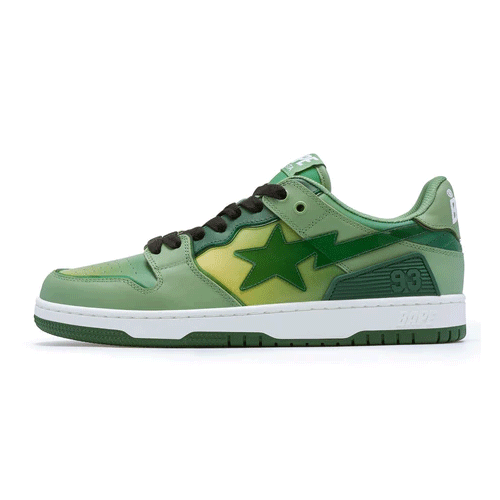Few sneakers have left as bold a mark on streetwear culture as the Bapesta. Born from the audacious vision of Japanese fashion label A Bathing Ape (BAPE), the Bapesta represents more than just footwear — it’s a cultural statement. Since its debut in the early 2000s, the sneaker has evolved into a global symbol of hype, exclusivity, and unmistakable design, catching the eye of hip-hop royalty and fashion purists alike.
In this in-depth guide, we’ll uncover the story behind the Bapesta, what makes it so iconic, how it became a global phenomenon, and why it remains relevant decades later.
The Origins of the Bapesta: A Japanese Take on American Icons
To understand the significance of the Bapesta, you first have to understand BAPE — short for A Bathing Ape — the brainchild of Japanese designer Nigo. Founded in 1993, BAPE was deeply rooted in Tokyo’s Ura-Harajuku scene, a subculture fueled by vintage Americana, music, and high-end urban fashion.
In 2002, Nigo introduced the Bapesta sneaker, inspired heavily by the Nike Air Force 1. With a similar silhouette, the Bapesta made no attempt to hide its influences. But it added a twist — swapping the iconic Nike swoosh for a bold shooting star logo and infusing each pair with vibrant colors, patent leather finishes, and loud graphic patterns that screamed individuality.
Unlike Nike’s more subdued color palettes of the time, Bapesta sneakers were a riot of colors — neon greens, candy pinks, camouflage prints — an approach that made them instantly recognizable and visually disruptive.
Why the Bapesta Stands Out in the Sneaker World
What made the Bapesta stand apart was not just its design, but the way it tapped into exclusivity and identity. Limited releases, small production batches, and high price points turned the sneaker into a streetwear status symbol.
Each pair of Bapestas is a bold statement. The glossy patent leather, which became a signature look, reflected the flashy Y2K aesthetic and matched BAPE’s overall visual branding — energetic, playful, and rebellious. The sneakers also aligned with the rise of logomania, where wearing a recognizable brand was an act of fashion bravado.
This made Bapestas a favorite among artists and influencers long before the era of Instagram-driven hype culture.
Bapesta in Hip-Hop and Pop Culture
The Bapesta sneaker’s rise is closely linked to hip-hop. During the early 2000s, artists like Pharrell Williams, Kanye West, and Lil Wayne began wearing BAPE, signaling a new fashion movement where luxury streetwear and music were intertwined.
Pharrell’s close collaboration with Nigo gave BAPE a huge boost in the West. When Kanye West released his own Bapesta design featuring the bear mascot from The College Dropout, it became one of the most coveted Bapesta editions of all time. The co-sign from Kanye solidified the sneaker’s place in both fashion and music history.
As hip-hop culture grew more intertwined with high fashion, Bapestas remained at the intersection — bridging Tokyo street fashion with American pop culture, and ultimately global sneaker culture.
Evolution Through Collaborations and Revivals
Like any enduring sneaker, the Bapesta owes part of its legacy to its collaborations. Over the years, BAPE has partnered with a wide range of brands and artists to reimagine the Bapesta. Collaborations with Marvel, Comme des Garçons, Undefeated, and Mastermind Japan have added fresh perspectives to the classic design.
Recent years have seen a Bapesta revival, with new drops that both honor its roots and appeal to a younger audience. BAPE has updated the silhouette, improved materials, and diversified the offerings. In a sneaker market saturated with retro releases, the Bapesta manages to stay relevant — partly due to nostalgia, partly because it still feels daring.
The brand has also leaned into limited edition releases and timed drops, strategies that keep Bapestas exclusive and desirable.
How to Style Bapestas: Making the Loud Sneaker Work
Bapestas are not for the faint-hearted. Their bold aesthetic demands a certain level of confidence and creativity. Styling them requires a balance between letting the shoes shine and maintaining a cohesive outfit.
Many opt to pair them with oversized streetwear fits, cargo pants, vintage band tees, or classic BAPE hoodies for a full-on streetwear look. Others incorporate them as the pop of color in a minimalist outfit. Regardless of approach, wearing Bapestas is about self-expression. They’re not just sneakers — they’re conversation starters.
For sneakerheads looking to build a versatile rotation, having a pair of Bapestas adds a unique silhouette and a touch of Y2K nostalgia to the collection.
Bapesta vs. Nike Air Force 1: A Legacy of Inspiration and Controversy
One cannot discuss Bapesta without mentioning the Air Force 1, which it famously mimics. The similarities sparked controversy when the Bapesta first appeared. Nike didn’t take legal action, perhaps due to jurisdiction complexities and the brand’s niche positioning at the time. Some critics accused BAPE of copying, while others praised the Bapesta as a bold reinterpretation.
Over time, the sneaker industry has seen many homages and reinterpretations, and the Bapesta has earned its place not as a knock-off, but as a cultural remix — one that injected energy, color, and an East Asian perspective into a largely Western-dominated scene.
Today, both sneakers can coexist in a collector’s rotation, each carrying its own cultural significance.
The Future of Bapesta in a Saturated Sneaker Market
In 2025, the sneaker world is more crowded than ever. With countless brands vying for attention and every drop becoming a digital event, standing out is harder than it used to be. Yet, the Bapesta still commands attention. Why?
Because it never tried to fit in.
Even after more than two decades, Bapesta releases still cause a stir. The brand continues to innovate while remaining true to its roots. The recent reimagining of the Bapesta Mid and the launch of custom platforms have shown BAPE’s commitment to evolution without compromise.
As Gen Z consumers seek authenticity and originality, Bapesta’s legacy as a countercultural icon makes it more relevant than ever. Its loud, unapologetic design speaks directly to a generation raised on boldness.
Final Thoughts: Why Bapesta Deserves a Spot in Sneaker History
The Bapesta is not just a sneaker — it’s a cultural artifact. It reflects a moment in fashion history where East met West, where underground streetwear influenced mainstream style, and where music, art, and sneakers collided.
For collectors, it offers a sense of nostalgia. For newcomers, it offers a piece of wearable art that challenges norms. And for fashion enthusiasts, it remains a perfect example of how design, branding, and storytelling can elevate footwear from functional to iconic.
Whether you’re investing in your first pair or hunting down a rare collab, owning a pair of Bapestas is owning a piece of streetwear history.





